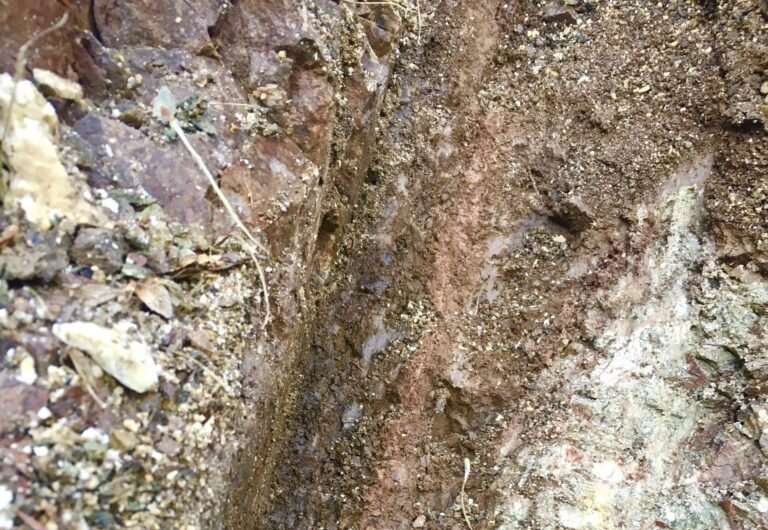Tracking ancient earthquakes by taking the temperatures of faults

Understanding ancient earthquakes helps researchers estimate the hazards posed by modern earthquakes. Reported in a new study, geologists have come up with a new way to estimate intensity of these old events: take their temperature.
During an earthquake, the temperature within a fault rises as the two sides slide past another. To get a close look at quake temperatures, the new Geochemistry, Geophysics, Geosystems study repurposed a backbone method of tectonics: zircon-based thermochronometry, where the amount of helium lost from a mineral grain is related to how hot it got.
The method is typically used to constrain Earth processes operating at scales of kilometers and millions of years as mountain ranges are built and destroyed, but the researchers applied it at smaller scales than ever before to detect earthquake temperatures.
"We're pushing this technique to its limits," said Emma Armstrong, lead author of the study and a thermochronologist at Utah State University. "There haven't been many studies done on short-duration, high-intensity events, or at these small spatial and temporal scales. We're talking about seconds of temperature rise here," she said.
Zircons and other minerals within the thin band of damaged material in a fault can record the brief, intensely hot temperatures rocks reach during a quake. Organic molecules preserved there do, too. Scientists can compare zircon and organic molecule records to pinpoint past earthquakes and see just how hot it got inside the fault during these ruptures, telling them how much energy was released.
The researchers tested their technique at the Punchbowl fault, a major inactive fault that parallels the active San Andreas fault in the Los Angeles area. "A paleo-San Andreas fault" that was active several million years ago, as study co-author and Utah State University thermochronologist and earthquake geologist Alexis Ault described it. Previously, co-authors Heather Savage, an earthquake geologist, and Pratigya Polissar, a geochemist, both at University of California Santa Cruz, used the organic molecule technique on the same rocks.
In the new study, the researchers aimed to see how well the two techniques agree across the fault, testing how widely fault temperatures could have varied during earthquakes.
The researchers used tiny samples of damaged fault rocks, called fault gouge, from within a two- to 10-centimeter band at the heart of the fault's deformation, as well as the 10 centimeters surrounding it. To estimate the earthquake's temperatures during the fault's last rupture, the team analyzed zircons, which are resilient minerals that can withstand the intense conditions of an earthquake. By measuring how much helium was left in the fault's zircon crystals, they estimated the fault reached temperatures around 700 degrees Celsius in the past, which could indicate large-magnitude earthquakes.
The zircon-based temperature range overlaps with previous estimates based on organic material, around 450 to 1050 degrees Celsius, but also refines previous estimates of earthquake temperatures. This suggests that if one method is not available for taking an earthquake's temperature, scientists could apply the other. The researchers also found that temperature varied along the fault, correlating with the width of that narrow band of intensely deformed rock.
"We theoretically predicted this, but it's not commonly observed in real datasets," said Ault. "So to show that and support prior work was exciting."
Armstrong and Ault are eager to try this new earthquake-thermometer method on other important faults and aim to incorporate other data to further hone estimates for ancient quakes' temperatures and magnitude.
"Zircon thermochronometry is a classic tool that we can use in new ways to identify what could have been a catastrophic event in the geologic past that is otherwise cryptic today," said Armstrong.
More information: E. M. Armstrong et al, A Multi‐Proxy Approach Using Zircon (U‐Th)/He Thermochronometry and Biomarker Thermal Maturity to Robustly Capture Earthquake Temperature Rise Along the Punchbowl Fault, California, Geochemistry, Geophysics, Geosystems (2022). DOI: 10.1029/2021GC010291
Provided by American Geophysical Union
This story is republished courtesy of Eos, hosted by the American Geophysical Union. Read the original story here.





















